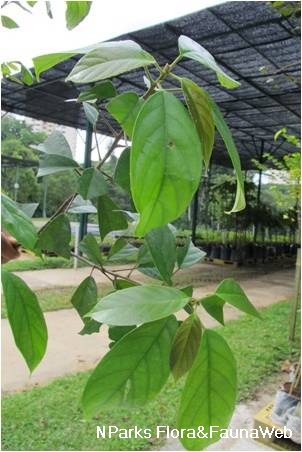_lowres.jpg)
Back
Baccaurea bracteata Müll.Arg.
| Family Name: | Phyllanthaceae |
| Common Name: | Rambai Tikus |
Baccaurea bracteata, also known as Rambai Tikus, is a tree which is critically endangered in Singapore. Flowers occur in long clusters on the branches. Fruit is round, reddish brown and splits into 3 parts when ripe. The fruit pulp is yellow and edible but sour.
Name
Classifications and Characteristics
| Plant Division | Angiosperms (Flowering Seed Plants) |
|---|---|
| Plant Growth Form | Tree (Medium (16m-30m)) |
| Lifespan (in Singapore) | Perennial |
| Mode of Nutrition | Autotrophic |
| Maximum Height | 25 m |
Biogeography
| Native Distribution | Peninsular Thailand, Sumatra, Peninsular Malaysia, Singapore and Borneo |
|---|---|
| Native Habitat | Terrestrial |
| Preferred Climate Zone | Tropical |
| Local Conservation Status | Native to Singapore (Vulnerable (VU)) |
Description and Ethnobotany
| Growth Form | It is a small tree up to 25 m tall, with a round crown. |
|---|---|
| Trunk | Its bark is a light grey-brown and covered with minute scales. |
| Foliage | Its alternate, long-stalked leaves possess papery to somewhat leathery leaf blades that are egg-shaped to oval to drop-shaped, and 3.5–21 by 1.7–9.8 cm. Its young leaves have leaf blades that are whitish to dark-green above, and white to pale-green below. |
| Flowers | Its branched, male flowering clusters are up to 16 cm long, and bear up to 100 red, 1.5–2.9 mm-wide, male flowers. Leaf-like bracts are also present below the male flowering clusters. Its female flowering clusters are up to 6.5 cm long, and bear up to 30 female flowers that are 4–12 mm wide, and yellowish to greenish to red-brown. |
| Fruit | Its round fruits are dark reddish-brown and 1.9–2.5 cm wide. They are three-shouldered, and found in 1–2 together on 5–10 cm-long shoots on the twigs and branches. They split into three parts when ripe to reveal three to six seeds in yellow, sour pulp. Its seeds are ovoid to drop-shaped, and 4–6.5 mm wide. |
| Habitat | It grows in primary or secondary, freshwater swamp, heath swamp or peat swamp forests, up to 900 m altitude. It occurs locally in Nee Soon Swamp Forest. |
| Associated Fauna | Its flowers are insect-pollinated. |
| Cultivation | It can be propagated by seed. |
| Etymology | Latin bacca, berry; Latin aurea, golden referring to the golden colour of the berries; Latin bracteata means having bracts (a modified leaf generally associated with the flower or flower cluster), referring to the plant’s bracts in the male flowering clusters |
| Ethnobotanical Uses | Edible Plant Parts : Edible Fruits Food (Fruit or Vegetable): The fruit pulp is edible but sour. Timber & Products: The timber is reported to be of good quality. Others: In Sarawak, the shoots are used in constructing ‘laminaang’ (a type of longhouse found in the Dayak Kenyah village). |
Landscaping Features
| Landscape Uses | Suitable for Roadsides, Parks & Gardens, Pond / Lake / River |
|---|
Fauna, Pollination and Dispersal
| Pollination Method(s) | Biotic (Fauna) |
|---|
Plant Care and Propagation
| Light Preference | Full Sun |
|---|---|
| Water Preference | Lots of Water, Moderate Water, Little Water |
| Plant Growth Rate | Moderate |
| Rootzone Tolerance | Moist Soils, Waterlogged Soils, Fertile Loamy Soils |
| Propagation Method | Seed |
Foliar
| Mature Foliage Colour(s) | Green, White |
|---|---|
| Mature Foliage Texture(s) | Papery, Leathery |
| Foliar Shape(s) | Non-Palm Foliage |
Floral (Angiosperm)
| Flower Colour(s) | Brown, Green, Red, Yellow / Golden |
|---|
Image Repository
Others
| Master ID | 30685 |
|---|---|
| Species ID | 4996 |
| Flora Disclaimer | The information in this website has been compiled from reliable sources, such as reference works on medicinal plants. It is not a substitute for medical advice or treatment and NParks does not purport to provide any medical advice. Readers should always consult his/her physician before using or consuming a plant for medicinal purposes. |

_lowres.jpg)
_lowres.jpg)
_lowres.jpg)
_lowres.jpg)
_lowres.jpg)
_lowres.jpg)







